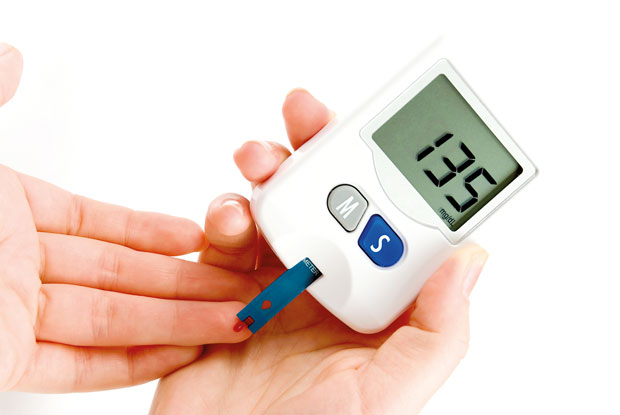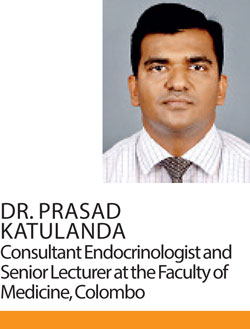Reply To:
Name - Reply Comment

 We’ve heard the lamentations of the older generation ‘apey amma muttha kalewath mehema leda thibila na’, (We didn’t have these kind of diseases during our parent’s time), when talking about Diabetes and other non communicable diseases. The number of patients with Diabetes is undoubtedly at an all time high and keeps amplifying. That’s why, on the week that we celebrate World Diabetes Day (falling on 14th November), we consulted Dr. Prasad Katulanda, Consultant Endocrinologist and Senior Lecturer at the Faculty of Medicine, Colombo, and the Chairman of the Sri Lanka Diabetes Federation to find out the reasons behind this rise in numbers. We also obtained the doctor’s advice on how best to cope with this condition, on behalf of readers, who have to live with diabetes.
We’ve heard the lamentations of the older generation ‘apey amma muttha kalewath mehema leda thibila na’, (We didn’t have these kind of diseases during our parent’s time), when talking about Diabetes and other non communicable diseases. The number of patients with Diabetes is undoubtedly at an all time high and keeps amplifying. That’s why, on the week that we celebrate World Diabetes Day (falling on 14th November), we consulted Dr. Prasad Katulanda, Consultant Endocrinologist and Senior Lecturer at the Faculty of Medicine, Colombo, and the Chairman of the Sri Lanka Diabetes Federation to find out the reasons behind this rise in numbers. We also obtained the doctor’s advice on how best to cope with this condition, on behalf of readers, who have to live with diabetes.
How big is the problem?
When it comes to Diabetes, there are two major types. Type 1 diabetes is the kind where the small children suffer from. In this group of patients the tissues don’t produce insulin at all, which requires lifelong insulin therapy. Today we’ll be focusing more on adult onset Diabetes also called type ii Diabetes, because it’s the disease which is most common and keeps the number of patients increasing.

If the readers of Health Capsule aren’t victims of diabetes themselves, it is highly likely that at least one of their loved ones are suffering from this disease. Exactly how common is diabetes? “According to data from the islandwide survey done in 2010, 10% of the general population were suffering from Diabetes. But today, based upon the data from smaller scale surveys, we assume that at least 15% of the general population are suffering from diabetes. This is even more of a problem in the urban areas, of which we expect more than 20% of the population to be diabetic. In addition, another 15% of the general population is expected to be in the pre-diabetic stage. These people run a high risk of developing diabetes later in life,” explained Dr. Katulanda.
Why the increase?
It all lies in the gap between the energy gain and expenditure, according to Dr. Katulanda. If we turn the pages of time, humans were working hard for generations. As hunter gatherers, then farmers and manual workers, we have been burning large amounts of calories per day. With the industrial revolution, our machines are doing most of the work, while we sit and direct them with our fingers. In addition, to replace the grains, vegetables and food that contains fiber we had those days, we have delicacies made of refined flour and sugar; which are hard to resist. “This lack of exercise as well as eating more means that the gap between our energy gain and energy expenditure is widening every day,” explains the doctor further stating that the storage of excessive energy as fat in the body causes obesity and leads to diabetes.
Focus on control
“Diabetes is defined as the chronic elevation of blood glucose. When uncontrolled diabetes continues for a considerable time, blood sugar levels reach high figures than they are meant to be, which can harm the body tissues,” said Dr. Katulanda.
“We have something called classical complications of Diabetes,” he explained. These classical complication comprise of
Retinopathy- Damage to the eyes
Nephropathy- Damage to the kidneys
Neuropathy – Damage to the nerves
In addition, people who are having uncontrolled diabetes are prone to develop problems in their feet, including poor wound healing capacity, which may even cause them to lose their feet, according to the doctor. They are also at a risk of developing heart attacks at a very young age and are more susceptible to ‘Silent Heart Attacks’, the latter presents with no chest pain, making the diagnosis harder.
Living with illness
Diabetes is a lifetime disease, needing a patient to alter his lifestyle to minimize future complications. Dr. Katulanda explained that the hardest part of living with diabetes is making those alterations. “We can’t ask a patient to stop eating. Even though we ask them to exercise, it’s a big commitment too. Such a practice takes time and doing it every day needs to be made a habit,”said Dr. Katulanda.
But do it in a way that ensures your future health and well-being. Energy needs differ with the individual, depending on various circumstances. For an example, a manual labourer will need more energy in his meals compared to a sedentary worker like a software engineer or a telephone operator who needs less.
“It’s generally assumed that a person leading a relatively sedentary lifestyle will require one cup of rice per meal which is equivalent to 6/8 string hoppers, 2/3 pieces of bread or 1 ¼ cup of grain,” advised the doctor.
He explained that limiting a patient’s food intake in itself is not enough because some foods contain higher energy and some the opposite, hence the food needs to be balanced out. Some types of food like green vegetables (string beans, cabbage, ladies fingers, dambala, green leaves) can be taken in abundance. Yellow vegetables like pumpkin and carrot should be taken in lower quantities since they contain higher levels of sugar. This can be combined with moderate amounts of animal food like fish, lean meat and eggs. “Refined sugar should be avoided as much as possible, or stopped altogether, since they pose the most danger,” he affirmed.
A person should have at least 150 minutes of exercise per week, which needs to be spread through the week, according to Dr. Katulanda. “The accepted method is 30 minutes per 5 days of the week,” he stated, adding that these activities need to be balanced out with a combination of aerobic and strength training exercises. “When it comes to children, they need at least 7 hours of exercise per week, which is more compared to an adult,” he added.
In people with disabilities, the need for exercise remains the same. But he cautioned that these patients shouldn’t make their conditions worse due to the strain of exercise. Ideally, expert opinion should be sought, from a physiotherapist or an exercise specialist.
Women and diabetes
This year’s theme for World Diabetes Day is women and diabetes, with Sri Lankan theme modified into ‘Healthy women, Healthy Nation’. ‘Why the special interest in women?’, we asked the doctor, who is deeply involved in the organizing of the Diabetes Day activities in Sri Lanka. He had an extremely intriguing answer. “Sri Lankan women play a central role in the family. They are the ones who usually decide on the types and the amount of meals for the family, the ingredients and how healthy they should be. They have a big influence over the physical exercise of the family too,” he explained. “Women’s health when it comes to diabetes is also extremely important. Women are susceptible to the disease called Gestational diabetes during the pregnancy, which carries huge risks. In addition, prevalence of diabetes in women is higher than with men, especially in Asian countries like ours,” he continued.
Husband prone to get diabetes if wife is obese
“Having an obese wife substantially increases the risk of Diabetes in older men”, reveals a study conducted in England during 2002 - 2015. We’ve known all along that relatives of the Diabetic patients have a higher risk of getting diabetes. But how does the wife’s BMI affect the husband? The doctors who conduct the study believe that this has much to do with the fact that women were more responsible for the diet of the family. One more reason for the menfolk to pay more attention to your wife’s health and fitness!
Myths surrounding treatment
“There are many myths when it comes to treatment for diabetes, and almost all of them are baseless. I see people more worried about the treatment than they are about their blood sugar levels,” the doctor stated, talking about treatment for diabetes.
“There are many treatment options with newer drugs being added to the list frequently. Your doctor will decide on the optimum treatment method for you, based on individual specific factors. Follow your doctor’s advise and take proper treatment without being misguided by the myths surrounding very effective drugs like insulin and metformin,” concluded the doctor.